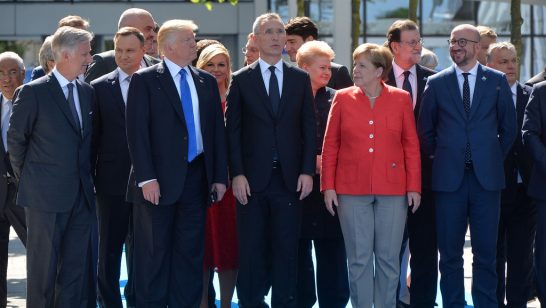
European security continues to be dominated by the crisis in Ukraine and the resulting rupture in relations between the West – the United States, NATO and the European Union (EU) – and Russia. Washington’s recent determination that Russia has violated the Intermediate-Range Nuclear Forces (INF) Treaty underscores what was already a grim outlook for security policy and arms control in Europe. An increased effort by NATO to reassure Allies, strengthen its defense capabilities, and deter Russian political, economic or military aggression against NATO member states is now underway. This effort is likely to require substantially more in the way of resources from Washington and its Allies.
There is both a security and essential budgetary incentive for NATO to try to implement reassurance and defense policies in ways that seek to preserve existing areas of cooperation with Russia and leave open pathways for rebuilding trust. Expanding on existing agreements in the months ahead – in particular strengthening the Vienna Document’s measures relating to conventional forces in Europe – would have both practical and political significance for the immediate crisis in Ukraine and the broader crisis in European security. Finally, following the NATO summit in Wales, new NATO requirements relating to conventional reassurance and defense could be the catalyst to a change in NATO’s nuclear posture over the next few years so that it is more credible, safer and affordable; a substantial portion of the savings could be devoted to sustaining and expanding NATO’s reassurance initiatives.
Tumbling down the staircase
Russia today looks much more like a potential adversary to NATO, in particular to those countries that share its border with Russia and have heard clearly President Vladimir Putin’s statements regarding the protection of ethnic Russians outside of Russia. Senior Alliance officials and some NATO member states believe NATO’s assumptions about the nature of the relationship with Russia, and the unilateral commitments that were made in the context of the 1997 NATO-Russia Founding Act – in particular, those relating to not putting substantial conventional forces in new NATO member states – need to be reassessed in light of Russia’s complete disregard for democratic principles and Ukrainian sovereignty, independence and territorial integrity.
No matter the outcome of that reassessment leading up to and beyond the September NATO summit in Wales, it appears clear that achieving a true strategic partnership between NATO and Russia is now less likely than at any time since the early 1990s. As a result, the Alliance is refocusing on its core mission – the defense of NATO member states – and in particular, “reassurance” to new NATO member states that border Russia, an implicit rejection of any notion that NATO does not face an adversary to its east.
The longer the crisis in Ukraine festers, the harder it may be for the West and Russia to continue cooperation on even high-profile joint security objectives, such as nuclear nonproliferation and counterterrorism. Moreover, any hope of deepening existing cooperation or defining new cooperative approaches to what were already contentious security issues prior to the Ukraine crisis – e.g., missile defense, tactical nuclear weapons, cyber security – has been greatly diminished.
INF Controversy
Against the already bleak backdrop for Euro-Atlantic security stemming from the Ukraine crisis comes this: according to the July 2014 State Department Arms Control Compliance Report, “The United States has determined that the Russian Federation is in violation of its obligations under the INF Treaty not to possess, produce, or flight-test a ground-launched cruise missile (GLCM) with a range capability of 500 km to 5,500 km, or to possess or produce launchers of such missiles.”
At least in theory, the severity of the INF blow to Euro-Atlantic security will depend on how Russia responds to the U.S. charge. That is, does Russia:
(a) stay in the Treaty, admit an INF violation and discontinue activities banned by the Treaty;
(b) stay in the Treaty, not admit to an INF violation, but discontinue activities banned by the treaty;
(c) stay in the Treaty, not admit to an INF violation, but then continue covertly with activities banned by the Treaty; or
(d) withdraw from the Treaty and continue with activities that were banned by the Treaty.
An admission by President Putin that Russia has violated the INF Treaty seems extremely unlikely. Perhaps only slightly less unlikely is that Moscow will discontinue – under U.S. pressure during the current crisis – activities and programs they have already decided were so important to Russian security that they merited an illegal covert program.
Hence, the more likely outcomes are for Russia to try to stay in INF, not admit a violation, but continue covert activities – seeking to avoid the diplomatic baggage of both admitting a violation and withdrawing from the Treaty – or to finally execute the option they have been threatening for many years: a clean withdrawal from INF. Neither of these two outcomes bodes well for U.S.-NATO-Russia relations.
Implications for security policy and arms control
Of course, even if Russian policy were to shift dramatically towards working with the Ukrainian government and the West on a political settlement and the long-term stabilization of Ukraine, and even if Moscow were to admit to and correct its INF violation, the flames of distrust that have been fanned over the past year may take many years to burn themselves out in many Western capitals. In other words: the damage has been done, and that damage may well have a lasting impact on security policy and arms control in the Euro-Atlantic region.
It seems unlikely that any new legally binding arms control agreements are in the cards for the next few years. Even before the Ukraine crisis, Moscow was cold to U.S. offers to negotiate further bilateral reductions in nuclear forces, and efforts to revive the Conventional Forces in Europe (CFE) Treaty were going nowhere fast. Added to this now is a heightened level of mistrust between the West and Russia that will be difficult to surmount – both in terms of negotiating any new legally binding agreements and achieving any necessary approval by legislatures, including the U.S. Senate. More likely than not in Washington, any work in this area will be left to the next U.S. administration.
That said, there may be some scope to build on existing agreements, in particular in the area of conventional forces, in the months ahead. An early point of emphasis could be the Vienna Confidence and Security Building Measures Document – which includes a range of measures applied to all OSCE countries. Steps to strengthen the Vienna Document’s measures relating to conventional forces in Europe would have both practical and political significance, both for the immediate crisis in Ukraine and the broader crisis in European security. In particular, steps in this area could make Russia appear less threatening to its neighbors and make NATO reassurance look less threatening to Russia.
Among the possibilities, participating states could agree to support increases in the number of visits and adjust the way observations are scheduled. This would open up the possibility to more effective and frequent observation of conventional force movements and concentrations. States could also consider regional military liaison missions – that is, reciprocal agreements between nations that would permit small numbers of officers to monitor activities in defined regions. This provision could be included as an expanded Vienna Document. At some point, there also may be opportunity for sub-regional approaches to confidence building measures, in particular in Central and Eastern Europe and the Baltic states, complimentary to the Vienna Document and closely coordinated within NATO.
Finally, the current crisis in Euro-Atlantic security may be the catalyst for a change in NATO’s nuclear posture following the NATO summit in Wales. Despite renewed calls by some for the Alliance to delay any changes to NATO’s nuclear posture (and to incur the substantial financial and political costs necessary to maintain the status quo), important decisions relating to that posture will need to be taken over the next few years – and will overlap with decisions relating to funding and the future direction of any reassurance activities.
For many, the crisis in Ukraine underlines that reassuring NATO Allies appears to be more strongly correlated to visible steps that can be tied to filling serious conventional capability gaps and addressing new “unconventional, non-nuclear” threats, rather than steps relating to tactical nuclear weapons capabilities that few if any believe are militarily useful. If U.S. tactical nuclear weapons in Europe have virtually no military utility, it is hard to argue they have any concrete value as a real deterrent in today’s – or tomorrow’s – Euro-Atlantic security space, in particular when the strategic forces of the United States, Great Britain and France remain visible and credible in any NATO context.
There is, however, a strong case to be made for a continuing reassurance requirement beyond two years (what is now budgeted in the U.S.), given the severity of the tear in the fabric of European security, and with the strong possibility that Mr. Putin remains president of Russia for another ten years. To pay for increasing the American military presence in Europe, more exercises and training, and building partner capacity, there will need to be new resources from Washington and Europe. Where will the resources come from?
One sensible part of the answer is for Washington and its NATO allies to move over the next few years to: reduce the staggering costs associated with a planned $13 billion modernization of the U.S. B61 nuclear bomb now stored in European bunkers and associated NATO Dual-Capable Aircraft (DCA); decisively alter the nuclear component of NATO’s defense posture; and use these savings to capitalize various reassurance initiatives over at least the next five years. Specifically, sometime after the Wales Summit, NATO would:
- Restate that as long as nuclear weapons exist, NATO will remain a nuclear alliance.
- Commit to restructure NATO’s nuclear deterrent so that it is more credible, safer and affordable. This will include:
- Maintaining the supreme guarantee provided by the strategic nuclear forces of the Alliance, particularly those of the United States and providing a more visible demonstration of this guarantee to European Allies (e.g., visits of U.S. strategic bombers to European bases);
- Modifying NATO nuclear sharing arrangements to enhance information sharing, consultations, common planning and common execution;
- The phased consolidation of U.S. tactical nuclear weapons now dispersed at bases in Europe to the United States and scaling back the U.S. B61 modernization program and associated DCA modernization.
- Commit to devote a substantial portion of the savings from restructuring NATO’s nuclear deterrent to sustaining and expanding reassurance over the next five years, to include contributions from both the United States and European Allies. This could provide an additional $1.5-$3 billion to reassurance (roughly double what is now in the budget) – a reasonable figure in light of estimated savings from scaling back the B61 modernization (perhaps as much as $8 billion), plans to make the F-35 nuclear capable (hundreds of millions of dollars) and recent commitments by a number of Allies to increase their defense spending.
That said, there are still NATO Allies who value the political symbolism of U.S. nuclear forces stationed in Europe – even more so given recent Russian actions in Ukraine. Even if these Allies can be convinced that maintaining the nuclear status quo within NATO is not necessary, or even counterproductive, to NATO security today, a political and diplomatic strategy would be necessary to ensure that governments, publics and any potential adversaries understand that a change in the nuclear status quo does not signal a reduced U.S. commitment to the Alliance – nor does it affect NATO’s capacity to remain a nuclear Alliance.
Back to Diplomacy
Finally, there are also important incentives for NATO to – at a minimum – do what it can to leave open pathways that could help define the contours of a new security strategy for the Euro-Atlantic region, one that looks beyond simply reassuring NATO. Indeed, that very effort may be the essential prerequisite to resolving the crisis in Ukraine in the years ahead. Leaders from the West should continue to offer to discuss with Russia pathways out of the current crisis. Without new diplomacy during this difficult period, efforts to reassure NATO in isolation risks contributing to another generation of East-West conflict.
The opinions articulated above represent the views of the author(s), and do not necessarily reflect the position of the European Leadership Network or any of its members. The ELN’s aim is to encourage debates that will help develop Europe’s capacity to address the pressing foreign, defence, and security challenges of our time.



